Construction Management: Off-site Modern Prefabricated Report
VerifiedAdded on 2021/06/17
|17
|4328
|25
Report
AI Summary
This report provides a comprehensive analysis of off-site prefabricated modern construction methods. It begins by defining off-site construction and explores the reasons for choosing this method, highlighting benefits such as improved quality, safety, cost efficiency, reduced waste, faster project timelines, minimal local disruption, and increased accuracy. The report then delves into the issues that need consideration when introducing these methods, including production equipment capital, equipment site requirements, construction time, modular coordination, and transport panel considerations. Furthermore, the report presents a detailed examination of value engineering, emphasizing its importance to organizations and individuals, including cost savings, stakeholder engagement, creativity and innovation, improved performance quality, procedural efficiency, and customer satisfaction. The report also discusses the benefits of value engineering for individuals, such as skill enhancement and increased commitment. The analysis aims to provide recommendations for construction directors and management teams, covering various aspects of designing and developing retail shops for different supermarket chains.
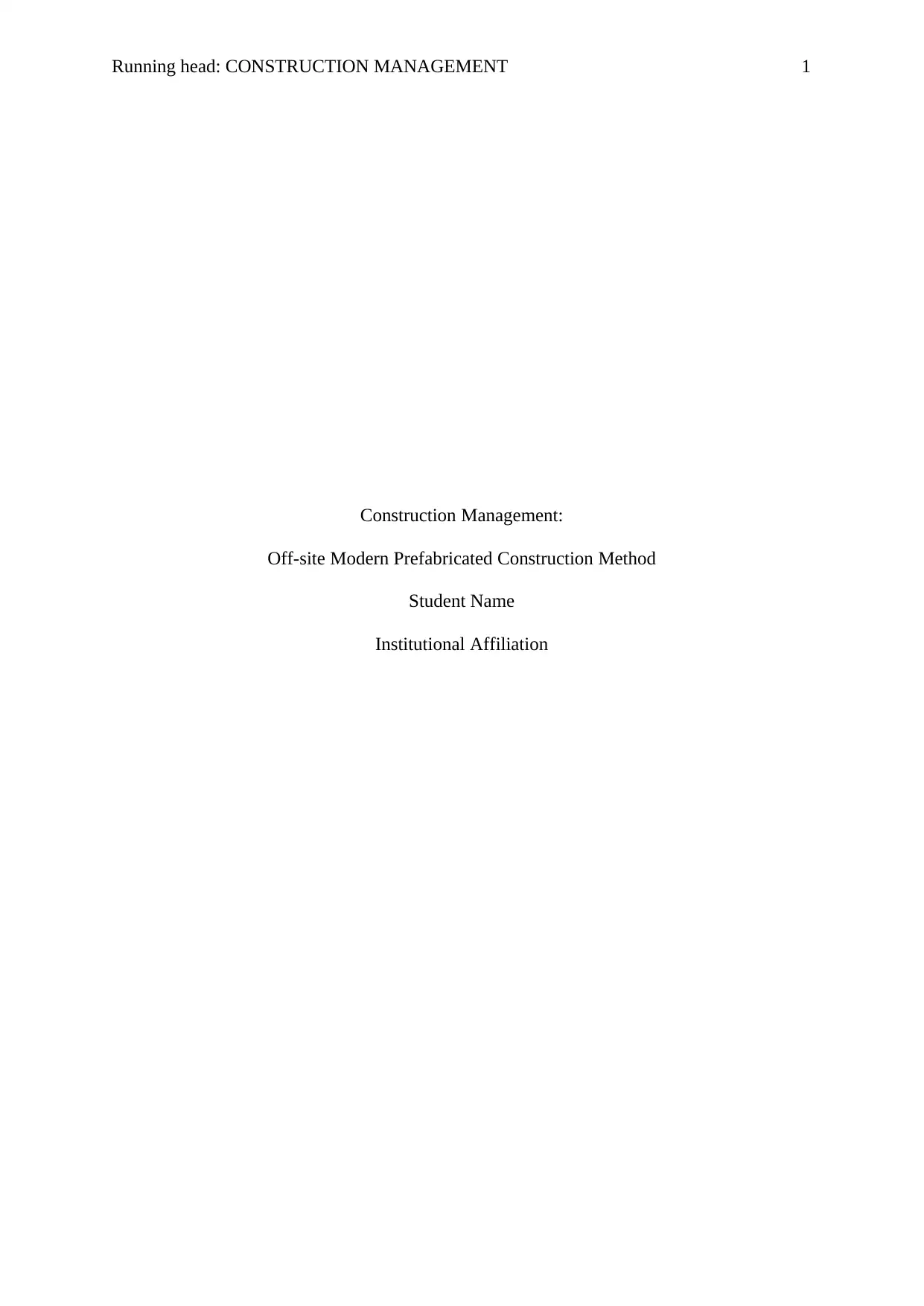
Running head: CONSTRUCTION MANAGEMENT 1
Construction Management:
Off-site Modern Prefabricated Construction Method
Student Name
Institutional Affiliation
Construction Management:
Off-site Modern Prefabricated Construction Method
Student Name
Institutional Affiliation
Secure Best Marks with AI Grader
Need help grading? Try our AI Grader for instant feedback on your assignments.
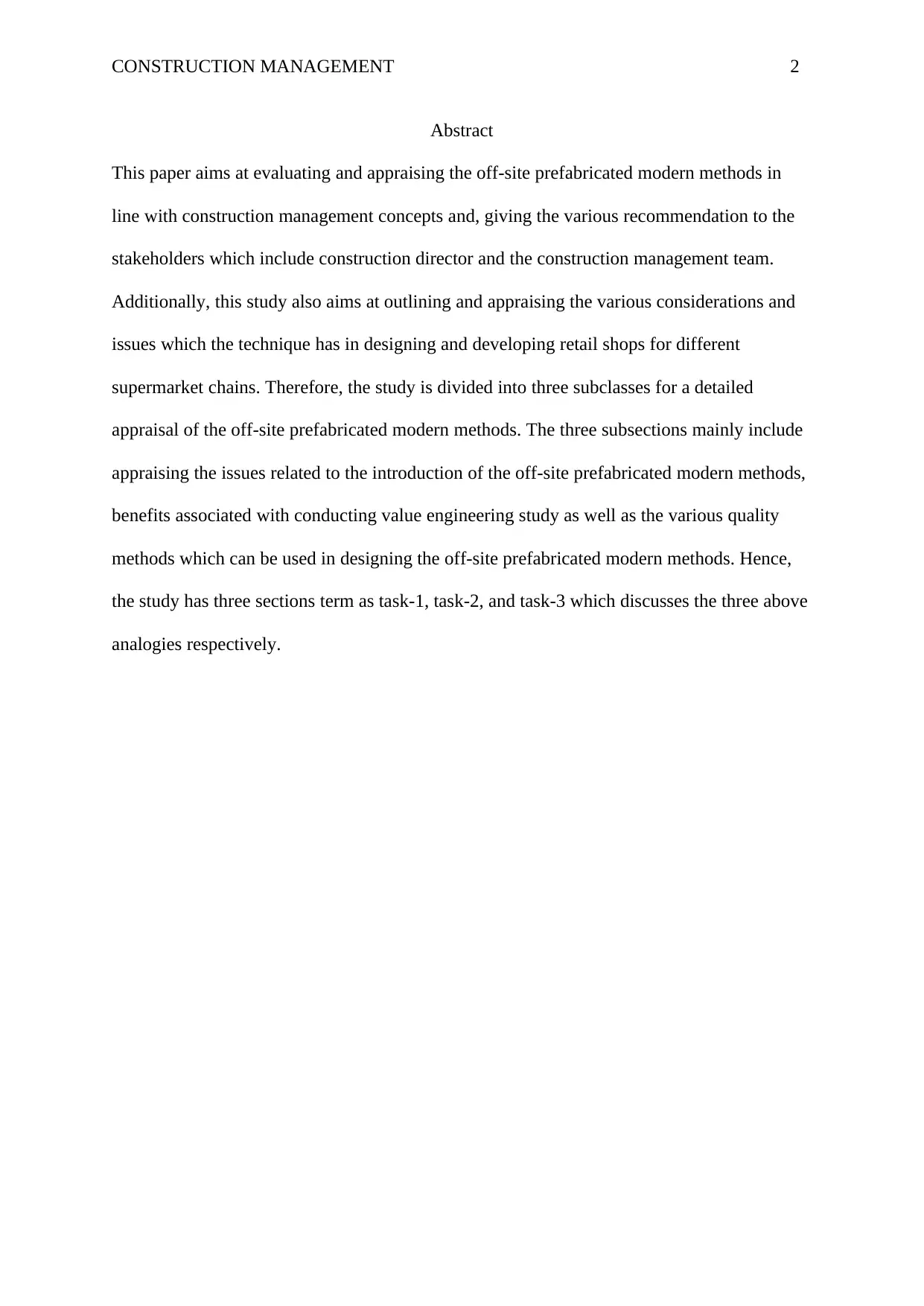
CONSTRUCTION MANAGEMENT 2
Abstract
This paper aims at evaluating and appraising the off-site prefabricated modern methods in
line with construction management concepts and, giving the various recommendation to the
stakeholders which include construction director and the construction management team.
Additionally, this study also aims at outlining and appraising the various considerations and
issues which the technique has in designing and developing retail shops for different
supermarket chains. Therefore, the study is divided into three subclasses for a detailed
appraisal of the off-site prefabricated modern methods. The three subsections mainly include
appraising the issues related to the introduction of the off-site prefabricated modern methods,
benefits associated with conducting value engineering study as well as the various quality
methods which can be used in designing the off-site prefabricated modern methods. Hence,
the study has three sections term as task-1, task-2, and task-3 which discusses the three above
analogies respectively.
Abstract
This paper aims at evaluating and appraising the off-site prefabricated modern methods in
line with construction management concepts and, giving the various recommendation to the
stakeholders which include construction director and the construction management team.
Additionally, this study also aims at outlining and appraising the various considerations and
issues which the technique has in designing and developing retail shops for different
supermarket chains. Therefore, the study is divided into three subclasses for a detailed
appraisal of the off-site prefabricated modern methods. The three subsections mainly include
appraising the issues related to the introduction of the off-site prefabricated modern methods,
benefits associated with conducting value engineering study as well as the various quality
methods which can be used in designing the off-site prefabricated modern methods. Hence,
the study has three sections term as task-1, task-2, and task-3 which discusses the three above
analogies respectively.
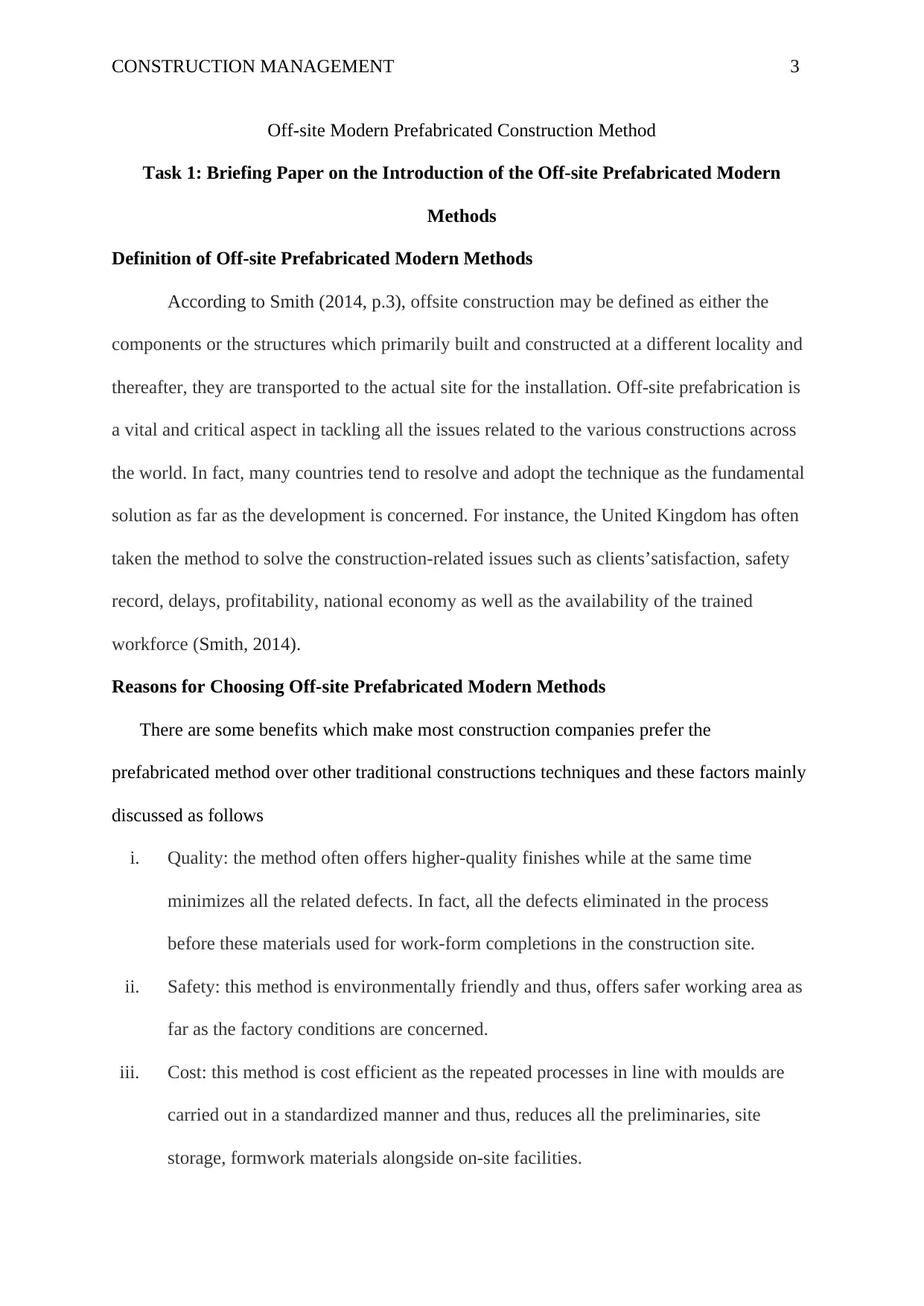
CONSTRUCTION MANAGEMENT 3
Off-site Modern Prefabricated Construction Method
Task 1: Briefing Paper on the Introduction of the Off-site Prefabricated Modern
Methods
Definition of Off-site Prefabricated Modern Methods
According to Smith (2014, p.3), offsite construction may be defined as either the
components or the structures which primarily built and constructed at a different locality and
thereafter, they are transported to the actual site for the installation. Off-site prefabrication is
a vital and critical aspect in tackling all the issues related to the various constructions across
the world. In fact, many countries tend to resolve and adopt the technique as the fundamental
solution as far as the development is concerned. For instance, the United Kingdom has often
taken the method to solve the construction-related issues such as clients’satisfaction, safety
record, delays, profitability, national economy as well as the availability of the trained
workforce (Smith, 2014).
Reasons for Choosing Off-site Prefabricated Modern Methods
There are some benefits which make most construction companies prefer the
prefabricated method over other traditional constructions techniques and these factors mainly
discussed as follows
i. Quality: the method often offers higher-quality finishes while at the same time
minimizes all the related defects. In fact, all the defects eliminated in the process
before these materials used for work-form completions in the construction site.
ii. Safety: this method is environmentally friendly and thus, offers safer working area as
far as the factory conditions are concerned.
iii. Cost: this method is cost efficient as the repeated processes in line with moulds are
carried out in a standardized manner and thus, reduces all the preliminaries, site
storage, formwork materials alongside on-site facilities.
Off-site Modern Prefabricated Construction Method
Task 1: Briefing Paper on the Introduction of the Off-site Prefabricated Modern
Methods
Definition of Off-site Prefabricated Modern Methods
According to Smith (2014, p.3), offsite construction may be defined as either the
components or the structures which primarily built and constructed at a different locality and
thereafter, they are transported to the actual site for the installation. Off-site prefabrication is
a vital and critical aspect in tackling all the issues related to the various constructions across
the world. In fact, many countries tend to resolve and adopt the technique as the fundamental
solution as far as the development is concerned. For instance, the United Kingdom has often
taken the method to solve the construction-related issues such as clients’satisfaction, safety
record, delays, profitability, national economy as well as the availability of the trained
workforce (Smith, 2014).
Reasons for Choosing Off-site Prefabricated Modern Methods
There are some benefits which make most construction companies prefer the
prefabricated method over other traditional constructions techniques and these factors mainly
discussed as follows
i. Quality: the method often offers higher-quality finishes while at the same time
minimizes all the related defects. In fact, all the defects eliminated in the process
before these materials used for work-form completions in the construction site.
ii. Safety: this method is environmentally friendly and thus, offers safer working area as
far as the factory conditions are concerned.
iii. Cost: this method is cost efficient as the repeated processes in line with moulds are
carried out in a standardized manner and thus, reduces all the preliminaries, site
storage, formwork materials alongside on-site facilities.
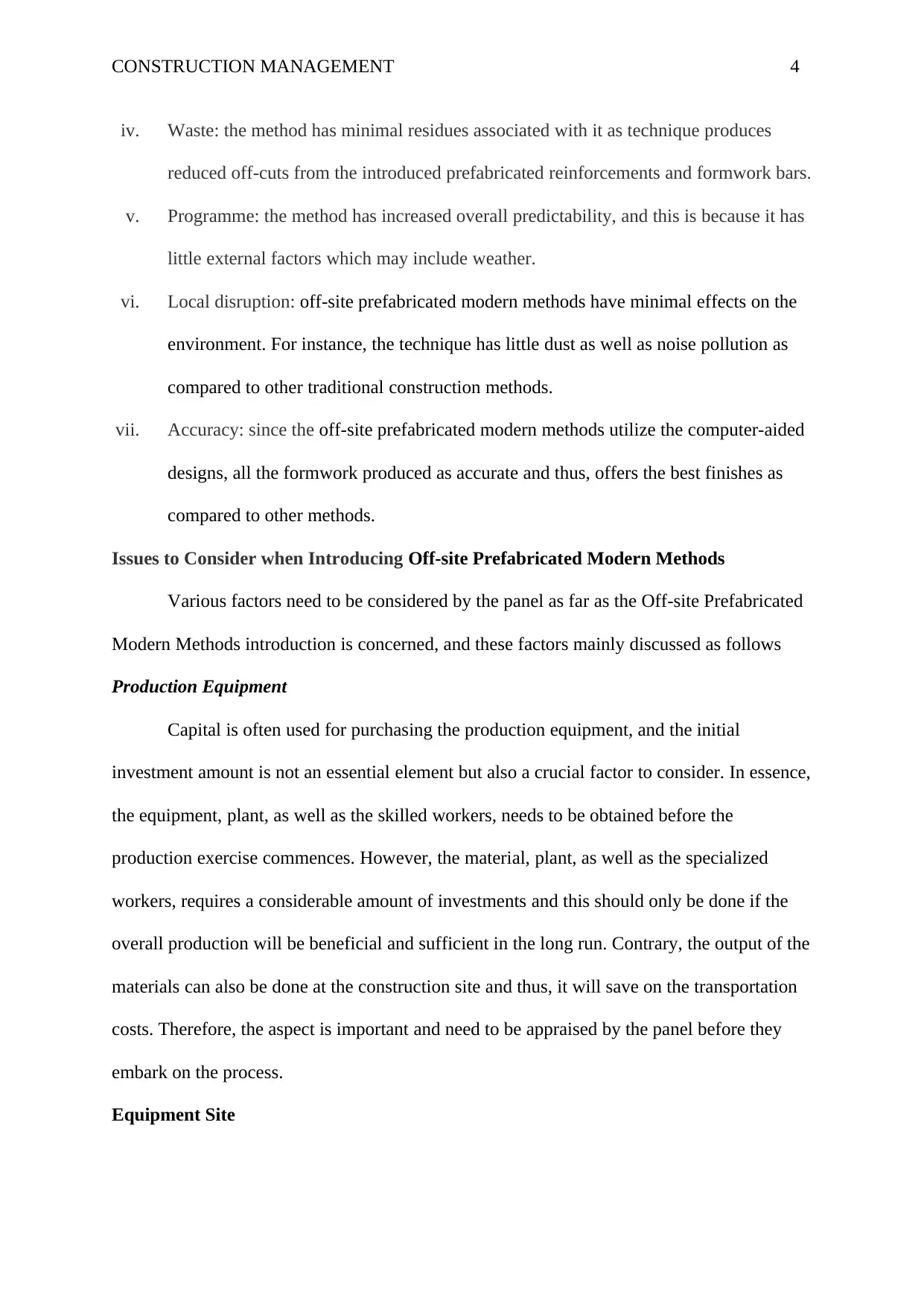
CONSTRUCTION MANAGEMENT 4
iv. Waste: the method has minimal residues associated with it as technique produces
reduced off-cuts from the introduced prefabricated reinforcements and formwork bars.
v. Programme: the method has increased overall predictability, and this is because it has
little external factors which may include weather.
vi. Local disruption: off-site prefabricated modern methods have minimal effects on the
environment. For instance, the technique has little dust as well as noise pollution as
compared to other traditional construction methods.
vii. Accuracy: since the off-site prefabricated modern methods utilize the computer-aided
designs, all the formwork produced as accurate and thus, offers the best finishes as
compared to other methods.
Issues to Consider when Introducing Off-site Prefabricated Modern Methods
Various factors need to be considered by the panel as far as the Off-site Prefabricated
Modern Methods introduction is concerned, and these factors mainly discussed as follows
Production Equipment
Capital is often used for purchasing the production equipment, and the initial
investment amount is not an essential element but also a crucial factor to consider. In essence,
the equipment, plant, as well as the skilled workers, needs to be obtained before the
production exercise commences. However, the material, plant, as well as the specialized
workers, requires a considerable amount of investments and this should only be done if the
overall production will be beneficial and sufficient in the long run. Contrary, the output of the
materials can also be done at the construction site and thus, it will save on the transportation
costs. Therefore, the aspect is important and need to be appraised by the panel before they
embark on the process.
Equipment Site
iv. Waste: the method has minimal residues associated with it as technique produces
reduced off-cuts from the introduced prefabricated reinforcements and formwork bars.
v. Programme: the method has increased overall predictability, and this is because it has
little external factors which may include weather.
vi. Local disruption: off-site prefabricated modern methods have minimal effects on the
environment. For instance, the technique has little dust as well as noise pollution as
compared to other traditional construction methods.
vii. Accuracy: since the off-site prefabricated modern methods utilize the computer-aided
designs, all the formwork produced as accurate and thus, offers the best finishes as
compared to other methods.
Issues to Consider when Introducing Off-site Prefabricated Modern Methods
Various factors need to be considered by the panel as far as the Off-site Prefabricated
Modern Methods introduction is concerned, and these factors mainly discussed as follows
Production Equipment
Capital is often used for purchasing the production equipment, and the initial
investment amount is not an essential element but also a crucial factor to consider. In essence,
the equipment, plant, as well as the skilled workers, needs to be obtained before the
production exercise commences. However, the material, plant, as well as the specialized
workers, requires a considerable amount of investments and this should only be done if the
overall production will be beneficial and sufficient in the long run. Contrary, the output of the
materials can also be done at the construction site and thus, it will save on the transportation
costs. Therefore, the aspect is important and need to be appraised by the panel before they
embark on the process.
Equipment Site
Secure Best Marks with AI Grader
Need help grading? Try our AI Grader for instant feedback on your assignments.
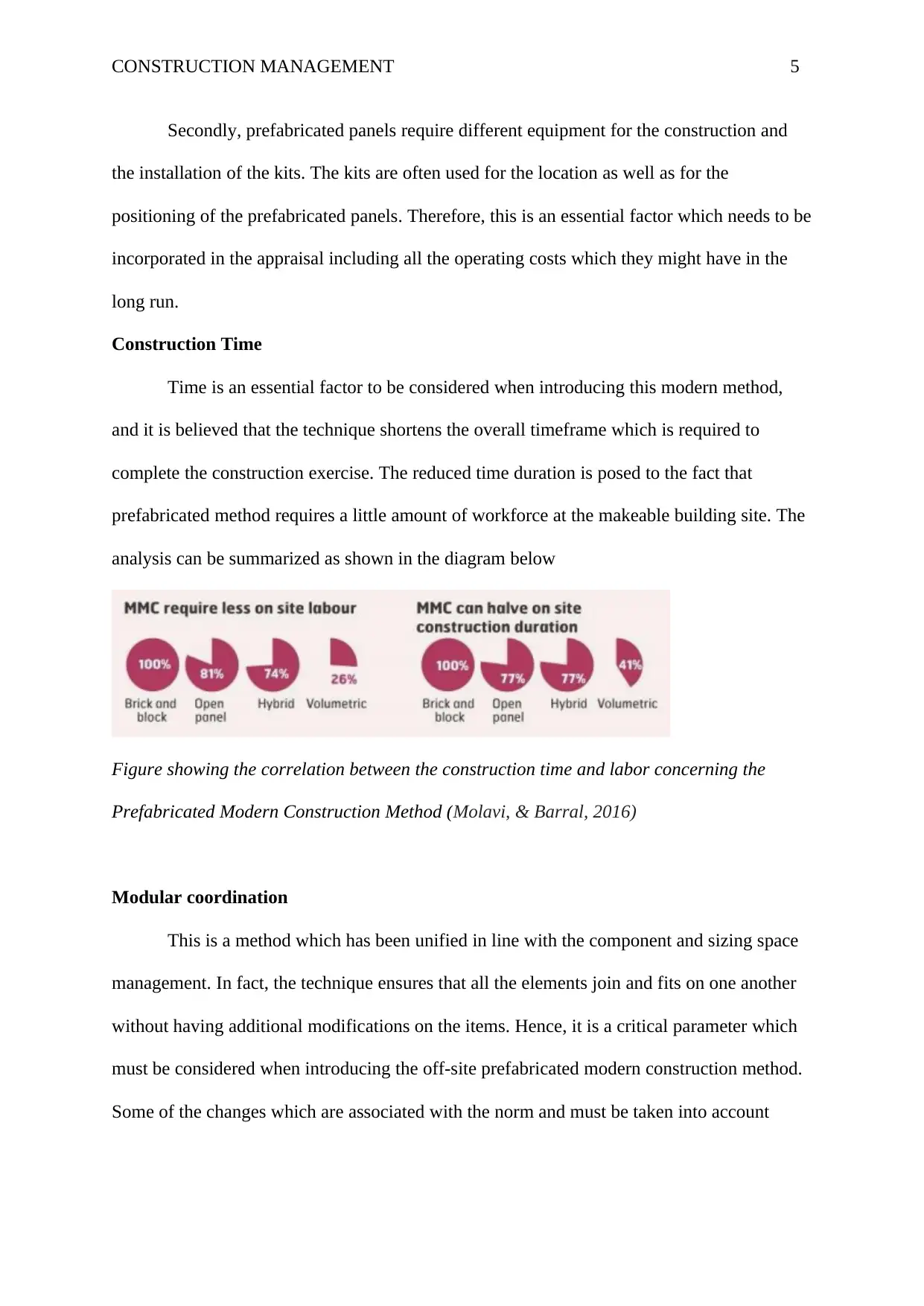
CONSTRUCTION MANAGEMENT 5
Secondly, prefabricated panels require different equipment for the construction and
the installation of the kits. The kits are often used for the location as well as for the
positioning of the prefabricated panels. Therefore, this is an essential factor which needs to be
incorporated in the appraisal including all the operating costs which they might have in the
long run.
Construction Time
Time is an essential factor to be considered when introducing this modern method,
and it is believed that the technique shortens the overall timeframe which is required to
complete the construction exercise. The reduced time duration is posed to the fact that
prefabricated method requires a little amount of workforce at the makeable building site. The
analysis can be summarized as shown in the diagram below
Figure showing the correlation between the construction time and labor concerning the
Prefabricated Modern Construction Method (Molavi, & Barral, 2016)
Modular coordination
This is a method which has been unified in line with the component and sizing space
management. In fact, the technique ensures that all the elements join and fits on one another
without having additional modifications on the items. Hence, it is a critical parameter which
must be considered when introducing the off-site prefabricated modern construction method.
Some of the changes which are associated with the norm and must be taken into account
Secondly, prefabricated panels require different equipment for the construction and
the installation of the kits. The kits are often used for the location as well as for the
positioning of the prefabricated panels. Therefore, this is an essential factor which needs to be
incorporated in the appraisal including all the operating costs which they might have in the
long run.
Construction Time
Time is an essential factor to be considered when introducing this modern method,
and it is believed that the technique shortens the overall timeframe which is required to
complete the construction exercise. The reduced time duration is posed to the fact that
prefabricated method requires a little amount of workforce at the makeable building site. The
analysis can be summarized as shown in the diagram below
Figure showing the correlation between the construction time and labor concerning the
Prefabricated Modern Construction Method (Molavi, & Barral, 2016)
Modular coordination
This is a method which has been unified in line with the component and sizing space
management. In fact, the technique ensures that all the elements join and fits on one another
without having additional modifications on the items. Hence, it is a critical parameter which
must be considered when introducing the off-site prefabricated modern construction method.
Some of the changes which are associated with the norm and must be taken into account
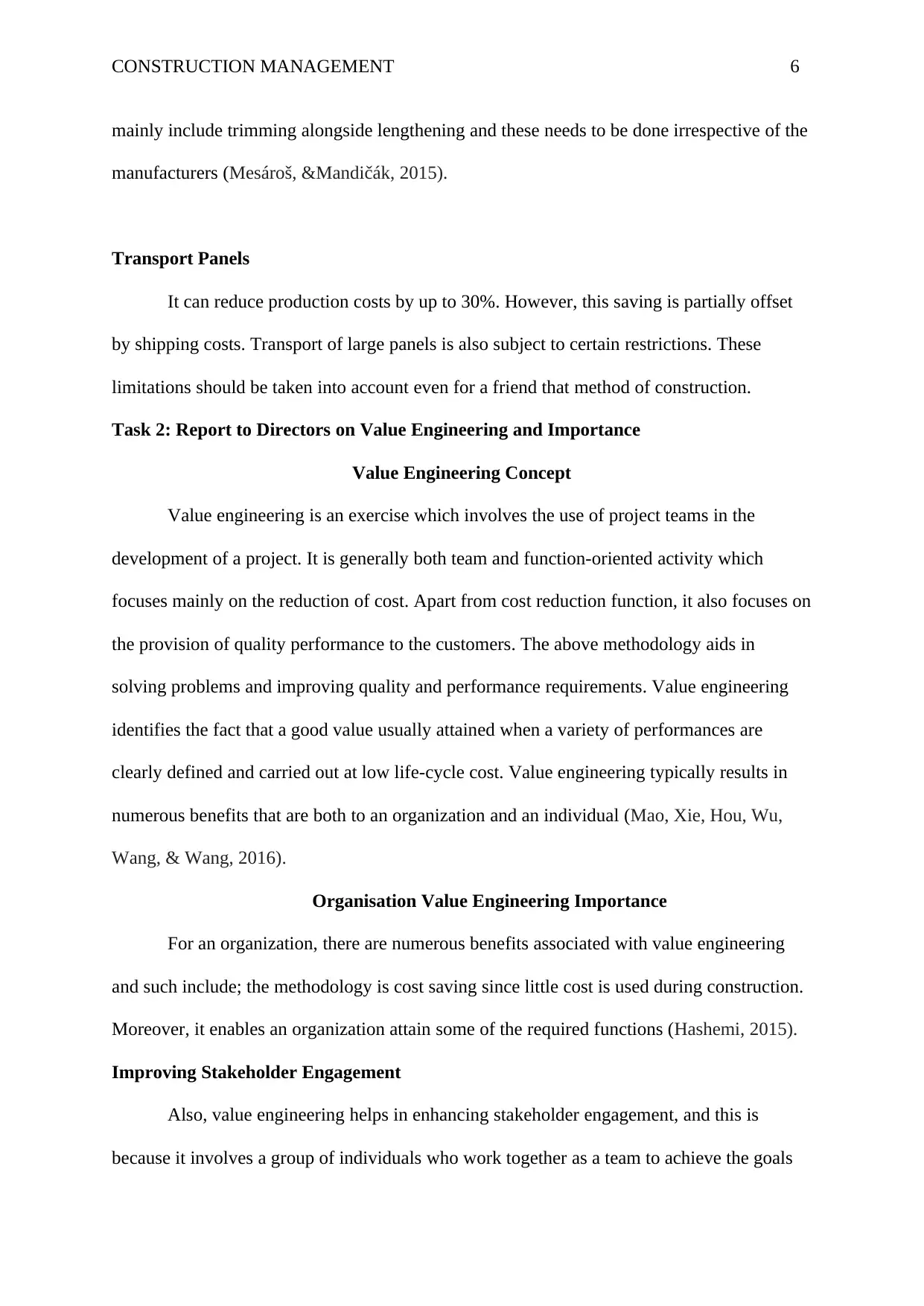
CONSTRUCTION MANAGEMENT 6
mainly include trimming alongside lengthening and these needs to be done irrespective of the
manufacturers (Mesároš, &Mandičák, 2015).
Transport Panels
It can reduce production costs by up to 30%. However, this saving is partially offset
by shipping costs. Transport of large panels is also subject to certain restrictions. These
limitations should be taken into account even for a friend that method of construction.
Task 2: Report to Directors on Value Engineering and Importance
Value Engineering Concept
Value engineering is an exercise which involves the use of project teams in the
development of a project. It is generally both team and function-oriented activity which
focuses mainly on the reduction of cost. Apart from cost reduction function, it also focuses on
the provision of quality performance to the customers. The above methodology aids in
solving problems and improving quality and performance requirements. Value engineering
identifies the fact that a good value usually attained when a variety of performances are
clearly defined and carried out at low life-cycle cost. Value engineering typically results in
numerous benefits that are both to an organization and an individual (Mao, Xie, Hou, Wu,
Wang, & Wang, 2016).
Organisation Value Engineering Importance
For an organization, there are numerous benefits associated with value engineering
and such include; the methodology is cost saving since little cost is used during construction.
Moreover, it enables an organization attain some of the required functions (Hashemi, 2015).
Improving Stakeholder Engagement
Also, value engineering helps in enhancing stakeholder engagement, and this is
because it involves a group of individuals who work together as a team to achieve the goals
mainly include trimming alongside lengthening and these needs to be done irrespective of the
manufacturers (Mesároš, &Mandičák, 2015).
Transport Panels
It can reduce production costs by up to 30%. However, this saving is partially offset
by shipping costs. Transport of large panels is also subject to certain restrictions. These
limitations should be taken into account even for a friend that method of construction.
Task 2: Report to Directors on Value Engineering and Importance
Value Engineering Concept
Value engineering is an exercise which involves the use of project teams in the
development of a project. It is generally both team and function-oriented activity which
focuses mainly on the reduction of cost. Apart from cost reduction function, it also focuses on
the provision of quality performance to the customers. The above methodology aids in
solving problems and improving quality and performance requirements. Value engineering
identifies the fact that a good value usually attained when a variety of performances are
clearly defined and carried out at low life-cycle cost. Value engineering typically results in
numerous benefits that are both to an organization and an individual (Mao, Xie, Hou, Wu,
Wang, & Wang, 2016).
Organisation Value Engineering Importance
For an organization, there are numerous benefits associated with value engineering
and such include; the methodology is cost saving since little cost is used during construction.
Moreover, it enables an organization attain some of the required functions (Hashemi, 2015).
Improving Stakeholder Engagement
Also, value engineering helps in enhancing stakeholder engagement, and this is
because it involves a group of individuals who work together as a team to achieve the goals
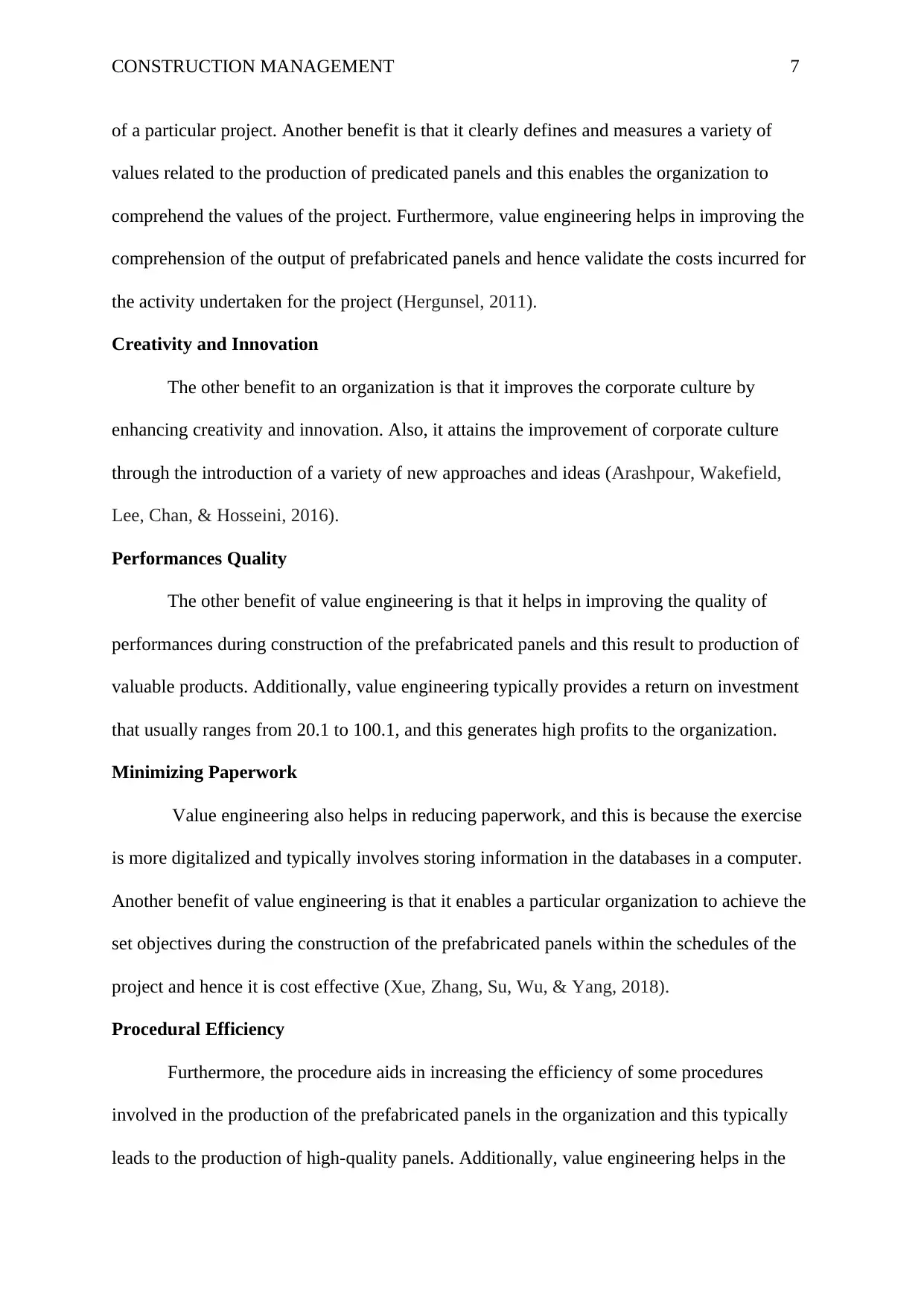
CONSTRUCTION MANAGEMENT 7
of a particular project. Another benefit is that it clearly defines and measures a variety of
values related to the production of predicated panels and this enables the organization to
comprehend the values of the project. Furthermore, value engineering helps in improving the
comprehension of the output of prefabricated panels and hence validate the costs incurred for
the activity undertaken for the project (Hergunsel, 2011).
Creativity and Innovation
The other benefit to an organization is that it improves the corporate culture by
enhancing creativity and innovation. Also, it attains the improvement of corporate culture
through the introduction of a variety of new approaches and ideas (Arashpour, Wakefield,
Lee, Chan, & Hosseini, 2016).
Performances Quality
The other benefit of value engineering is that it helps in improving the quality of
performances during construction of the prefabricated panels and this result to production of
valuable products. Additionally, value engineering typically provides a return on investment
that usually ranges from 20.1 to 100.1, and this generates high profits to the organization.
Minimizing Paperwork
Value engineering also helps in reducing paperwork, and this is because the exercise
is more digitalized and typically involves storing information in the databases in a computer.
Another benefit of value engineering is that it enables a particular organization to achieve the
set objectives during the construction of the prefabricated panels within the schedules of the
project and hence it is cost effective (Xue, Zhang, Su, Wu, & Yang, 2018).
Procedural Efficiency
Furthermore, the procedure aids in increasing the efficiency of some procedures
involved in the production of the prefabricated panels in the organization and this typically
leads to the production of high-quality panels. Additionally, value engineering helps in the
of a particular project. Another benefit is that it clearly defines and measures a variety of
values related to the production of predicated panels and this enables the organization to
comprehend the values of the project. Furthermore, value engineering helps in improving the
comprehension of the output of prefabricated panels and hence validate the costs incurred for
the activity undertaken for the project (Hergunsel, 2011).
Creativity and Innovation
The other benefit to an organization is that it improves the corporate culture by
enhancing creativity and innovation. Also, it attains the improvement of corporate culture
through the introduction of a variety of new approaches and ideas (Arashpour, Wakefield,
Lee, Chan, & Hosseini, 2016).
Performances Quality
The other benefit of value engineering is that it helps in improving the quality of
performances during construction of the prefabricated panels and this result to production of
valuable products. Additionally, value engineering typically provides a return on investment
that usually ranges from 20.1 to 100.1, and this generates high profits to the organization.
Minimizing Paperwork
Value engineering also helps in reducing paperwork, and this is because the exercise
is more digitalized and typically involves storing information in the databases in a computer.
Another benefit of value engineering is that it enables a particular organization to achieve the
set objectives during the construction of the prefabricated panels within the schedules of the
project and hence it is cost effective (Xue, Zhang, Su, Wu, & Yang, 2018).
Procedural Efficiency
Furthermore, the procedure aids in increasing the efficiency of some procedures
involved in the production of the prefabricated panels in the organization and this typically
leads to the production of high-quality panels. Additionally, value engineering helps in the
Paraphrase This Document
Need a fresh take? Get an instant paraphrase of this document with our AI Paraphraser
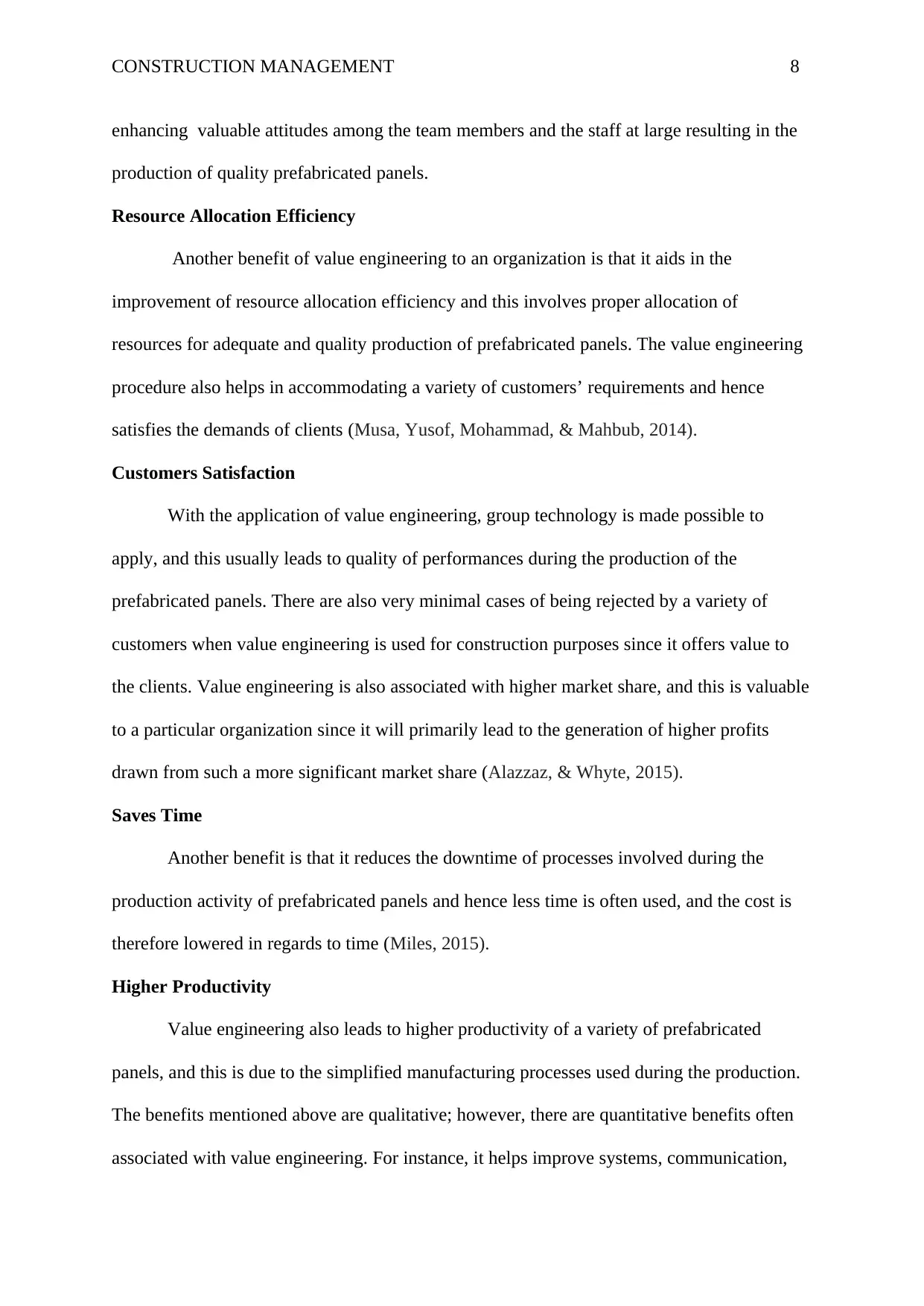
CONSTRUCTION MANAGEMENT 8
enhancing valuable attitudes among the team members and the staff at large resulting in the
production of quality prefabricated panels.
Resource Allocation Efficiency
Another benefit of value engineering to an organization is that it aids in the
improvement of resource allocation efficiency and this involves proper allocation of
resources for adequate and quality production of prefabricated panels. The value engineering
procedure also helps in accommodating a variety of customers’ requirements and hence
satisfies the demands of clients (Musa, Yusof, Mohammad, & Mahbub, 2014).
Customers Satisfaction
With the application of value engineering, group technology is made possible to
apply, and this usually leads to quality of performances during the production of the
prefabricated panels. There are also very minimal cases of being rejected by a variety of
customers when value engineering is used for construction purposes since it offers value to
the clients. Value engineering is also associated with higher market share, and this is valuable
to a particular organization since it will primarily lead to the generation of higher profits
drawn from such a more significant market share (Alazzaz, & Whyte, 2015).
Saves Time
Another benefit is that it reduces the downtime of processes involved during the
production activity of prefabricated panels and hence less time is often used, and the cost is
therefore lowered in regards to time (Miles, 2015).
Higher Productivity
Value engineering also leads to higher productivity of a variety of prefabricated
panels, and this is due to the simplified manufacturing processes used during the production.
The benefits mentioned above are qualitative; however, there are quantitative benefits often
associated with value engineering. For instance, it helps improve systems, communication,
enhancing valuable attitudes among the team members and the staff at large resulting in the
production of quality prefabricated panels.
Resource Allocation Efficiency
Another benefit of value engineering to an organization is that it aids in the
improvement of resource allocation efficiency and this involves proper allocation of
resources for adequate and quality production of prefabricated panels. The value engineering
procedure also helps in accommodating a variety of customers’ requirements and hence
satisfies the demands of clients (Musa, Yusof, Mohammad, & Mahbub, 2014).
Customers Satisfaction
With the application of value engineering, group technology is made possible to
apply, and this usually leads to quality of performances during the production of the
prefabricated panels. There are also very minimal cases of being rejected by a variety of
customers when value engineering is used for construction purposes since it offers value to
the clients. Value engineering is also associated with higher market share, and this is valuable
to a particular organization since it will primarily lead to the generation of higher profits
drawn from such a more significant market share (Alazzaz, & Whyte, 2015).
Saves Time
Another benefit is that it reduces the downtime of processes involved during the
production activity of prefabricated panels and hence less time is often used, and the cost is
therefore lowered in regards to time (Miles, 2015).
Higher Productivity
Value engineering also leads to higher productivity of a variety of prefabricated
panels, and this is due to the simplified manufacturing processes used during the production.
The benefits mentioned above are qualitative; however, there are quantitative benefits often
associated with value engineering. For instance, it helps improve systems, communication,
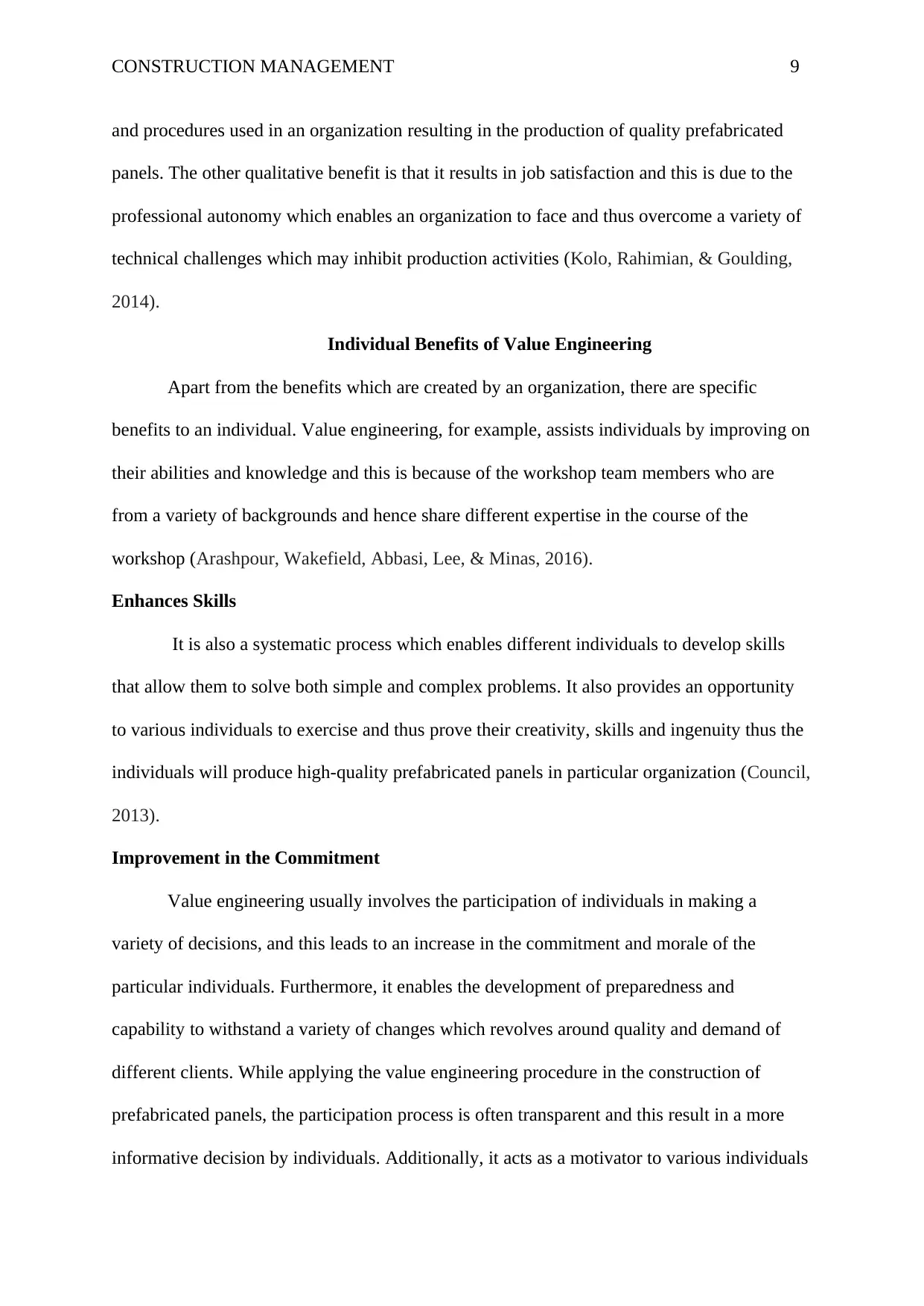
CONSTRUCTION MANAGEMENT 9
and procedures used in an organization resulting in the production of quality prefabricated
panels. The other qualitative benefit is that it results in job satisfaction and this is due to the
professional autonomy which enables an organization to face and thus overcome a variety of
technical challenges which may inhibit production activities (Kolo, Rahimian, & Goulding,
2014).
Individual Benefits of Value Engineering
Apart from the benefits which are created by an organization, there are specific
benefits to an individual. Value engineering, for example, assists individuals by improving on
their abilities and knowledge and this is because of the workshop team members who are
from a variety of backgrounds and hence share different expertise in the course of the
workshop (Arashpour, Wakefield, Abbasi, Lee, & Minas, 2016).
Enhances Skills
It is also a systematic process which enables different individuals to develop skills
that allow them to solve both simple and complex problems. It also provides an opportunity
to various individuals to exercise and thus prove their creativity, skills and ingenuity thus the
individuals will produce high-quality prefabricated panels in particular organization (Council,
2013).
Improvement in the Commitment
Value engineering usually involves the participation of individuals in making a
variety of decisions, and this leads to an increase in the commitment and morale of the
particular individuals. Furthermore, it enables the development of preparedness and
capability to withstand a variety of changes which revolves around quality and demand of
different clients. While applying the value engineering procedure in the construction of
prefabricated panels, the participation process is often transparent and this result in a more
informative decision by individuals. Additionally, it acts as a motivator to various individuals
and procedures used in an organization resulting in the production of quality prefabricated
panels. The other qualitative benefit is that it results in job satisfaction and this is due to the
professional autonomy which enables an organization to face and thus overcome a variety of
technical challenges which may inhibit production activities (Kolo, Rahimian, & Goulding,
2014).
Individual Benefits of Value Engineering
Apart from the benefits which are created by an organization, there are specific
benefits to an individual. Value engineering, for example, assists individuals by improving on
their abilities and knowledge and this is because of the workshop team members who are
from a variety of backgrounds and hence share different expertise in the course of the
workshop (Arashpour, Wakefield, Abbasi, Lee, & Minas, 2016).
Enhances Skills
It is also a systematic process which enables different individuals to develop skills
that allow them to solve both simple and complex problems. It also provides an opportunity
to various individuals to exercise and thus prove their creativity, skills and ingenuity thus the
individuals will produce high-quality prefabricated panels in particular organization (Council,
2013).
Improvement in the Commitment
Value engineering usually involves the participation of individuals in making a
variety of decisions, and this leads to an increase in the commitment and morale of the
particular individuals. Furthermore, it enables the development of preparedness and
capability to withstand a variety of changes which revolves around quality and demand of
different clients. While applying the value engineering procedure in the construction of
prefabricated panels, the participation process is often transparent and this result in a more
informative decision by individuals. Additionally, it acts as a motivator to various individuals
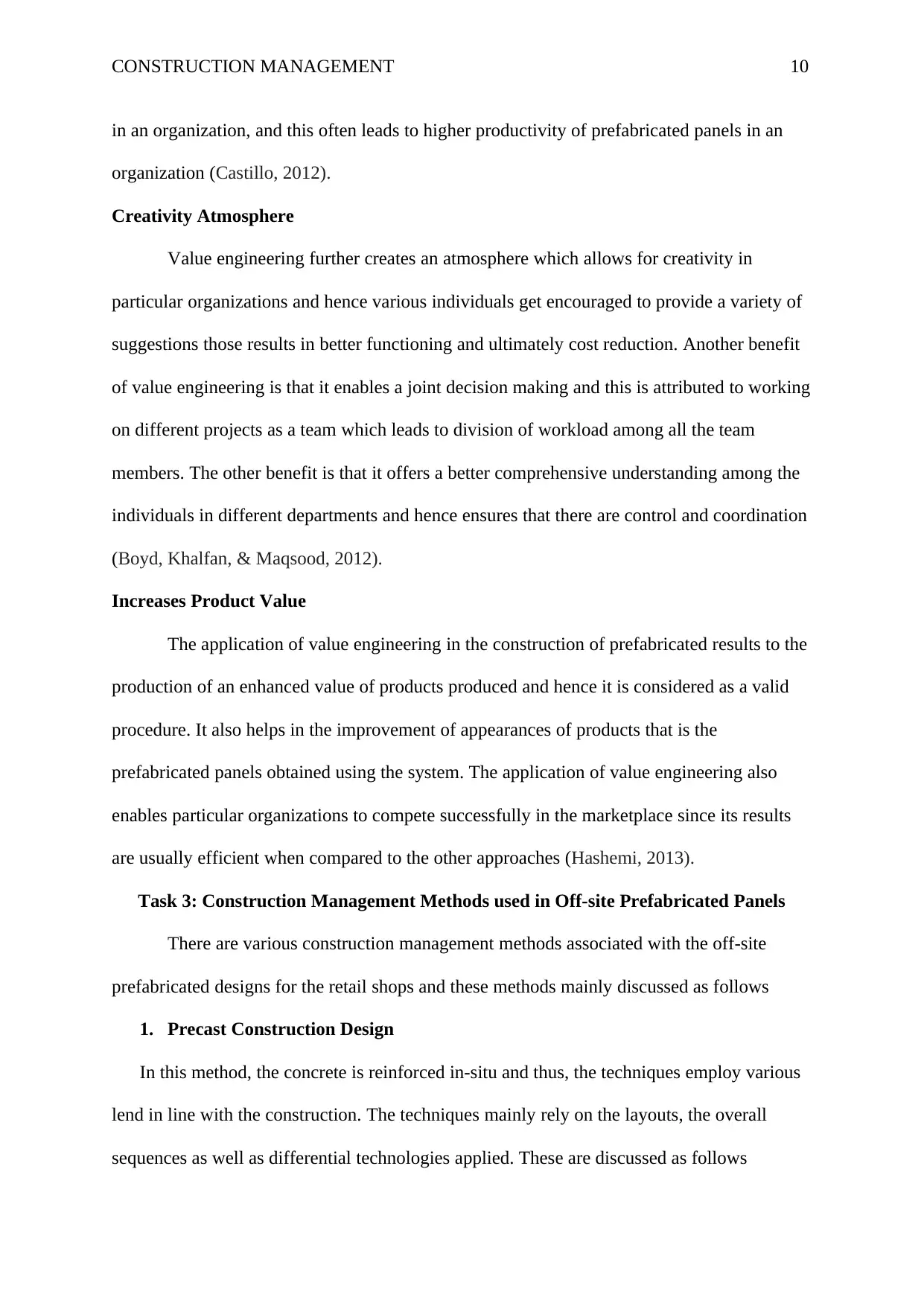
CONSTRUCTION MANAGEMENT 10
in an organization, and this often leads to higher productivity of prefabricated panels in an
organization (Castillo, 2012).
Creativity Atmosphere
Value engineering further creates an atmosphere which allows for creativity in
particular organizations and hence various individuals get encouraged to provide a variety of
suggestions those results in better functioning and ultimately cost reduction. Another benefit
of value engineering is that it enables a joint decision making and this is attributed to working
on different projects as a team which leads to division of workload among all the team
members. The other benefit is that it offers a better comprehensive understanding among the
individuals in different departments and hence ensures that there are control and coordination
(Boyd, Khalfan, & Maqsood, 2012).
Increases Product Value
The application of value engineering in the construction of prefabricated results to the
production of an enhanced value of products produced and hence it is considered as a valid
procedure. It also helps in the improvement of appearances of products that is the
prefabricated panels obtained using the system. The application of value engineering also
enables particular organizations to compete successfully in the marketplace since its results
are usually efficient when compared to the other approaches (Hashemi, 2013).
Task 3: Construction Management Methods used in Off-site Prefabricated Panels
There are various construction management methods associated with the off-site
prefabricated designs for the retail shops and these methods mainly discussed as follows
1. Precast Construction Design
In this method, the concrete is reinforced in-situ and thus, the techniques employ various
lend in line with the construction. The techniques mainly rely on the layouts, the overall
sequences as well as differential technologies applied. These are discussed as follows
in an organization, and this often leads to higher productivity of prefabricated panels in an
organization (Castillo, 2012).
Creativity Atmosphere
Value engineering further creates an atmosphere which allows for creativity in
particular organizations and hence various individuals get encouraged to provide a variety of
suggestions those results in better functioning and ultimately cost reduction. Another benefit
of value engineering is that it enables a joint decision making and this is attributed to working
on different projects as a team which leads to division of workload among all the team
members. The other benefit is that it offers a better comprehensive understanding among the
individuals in different departments and hence ensures that there are control and coordination
(Boyd, Khalfan, & Maqsood, 2012).
Increases Product Value
The application of value engineering in the construction of prefabricated results to the
production of an enhanced value of products produced and hence it is considered as a valid
procedure. It also helps in the improvement of appearances of products that is the
prefabricated panels obtained using the system. The application of value engineering also
enables particular organizations to compete successfully in the marketplace since its results
are usually efficient when compared to the other approaches (Hashemi, 2013).
Task 3: Construction Management Methods used in Off-site Prefabricated Panels
There are various construction management methods associated with the off-site
prefabricated designs for the retail shops and these methods mainly discussed as follows
1. Precast Construction Design
In this method, the concrete is reinforced in-situ and thus, the techniques employ various
lend in line with the construction. The techniques mainly rely on the layouts, the overall
sequences as well as differential technologies applied. These are discussed as follows
Secure Best Marks with AI Grader
Need help grading? Try our AI Grader for instant feedback on your assignments.
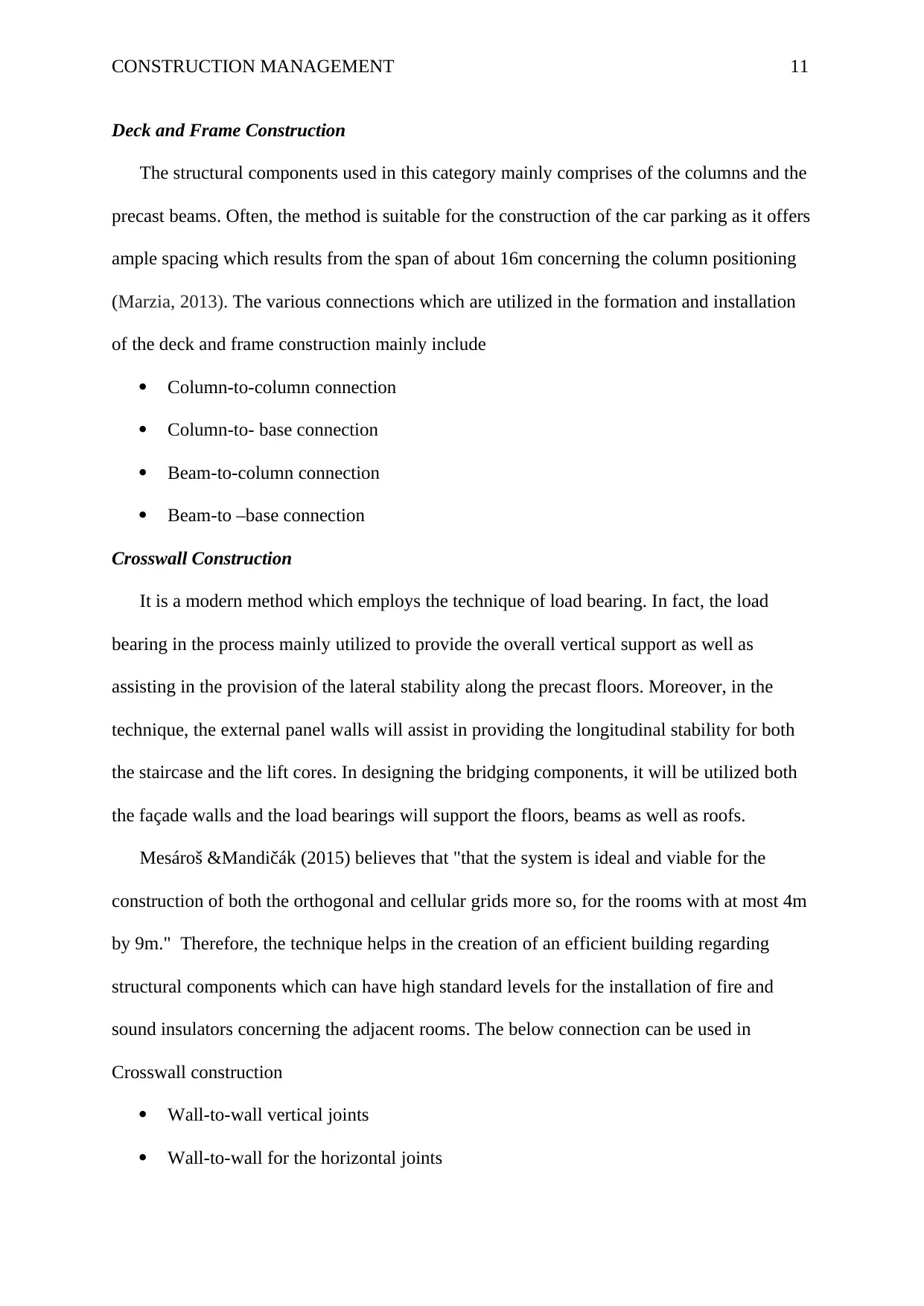
CONSTRUCTION MANAGEMENT 11
Deck and Frame Construction
The structural components used in this category mainly comprises of the columns and the
precast beams. Often, the method is suitable for the construction of the car parking as it offers
ample spacing which results from the span of about 16m concerning the column positioning
(Marzia, 2013). The various connections which are utilized in the formation and installation
of the deck and frame construction mainly include
Column-to-column connection
Column-to- base connection
Beam-to-column connection
Beam-to –base connection
Crosswall Construction
It is a modern method which employs the technique of load bearing. In fact, the load
bearing in the process mainly utilized to provide the overall vertical support as well as
assisting in the provision of the lateral stability along the precast floors. Moreover, in the
technique, the external panel walls will assist in providing the longitudinal stability for both
the staircase and the lift cores. In designing the bridging components, it will be utilized both
the façade walls and the load bearings will support the floors, beams as well as roofs.
Mesároš &Mandičák (2015) believes that "that the system is ideal and viable for the
construction of both the orthogonal and cellular grids more so, for the rooms with at most 4m
by 9m." Therefore, the technique helps in the creation of an efficient building regarding
structural components which can have high standard levels for the installation of fire and
sound insulators concerning the adjacent rooms. The below connection can be used in
Crosswall construction
Wall-to-wall vertical joints
Wall-to-wall for the horizontal joints
Deck and Frame Construction
The structural components used in this category mainly comprises of the columns and the
precast beams. Often, the method is suitable for the construction of the car parking as it offers
ample spacing which results from the span of about 16m concerning the column positioning
(Marzia, 2013). The various connections which are utilized in the formation and installation
of the deck and frame construction mainly include
Column-to-column connection
Column-to- base connection
Beam-to-column connection
Beam-to –base connection
Crosswall Construction
It is a modern method which employs the technique of load bearing. In fact, the load
bearing in the process mainly utilized to provide the overall vertical support as well as
assisting in the provision of the lateral stability along the precast floors. Moreover, in the
technique, the external panel walls will assist in providing the longitudinal stability for both
the staircase and the lift cores. In designing the bridging components, it will be utilized both
the façade walls and the load bearings will support the floors, beams as well as roofs.
Mesároš &Mandičák (2015) believes that "that the system is ideal and viable for the
construction of both the orthogonal and cellular grids more so, for the rooms with at most 4m
by 9m." Therefore, the technique helps in the creation of an efficient building regarding
structural components which can have high standard levels for the installation of fire and
sound insulators concerning the adjacent rooms. The below connection can be used in
Crosswall construction
Wall-to-wall vertical joints
Wall-to-wall for the horizontal joints
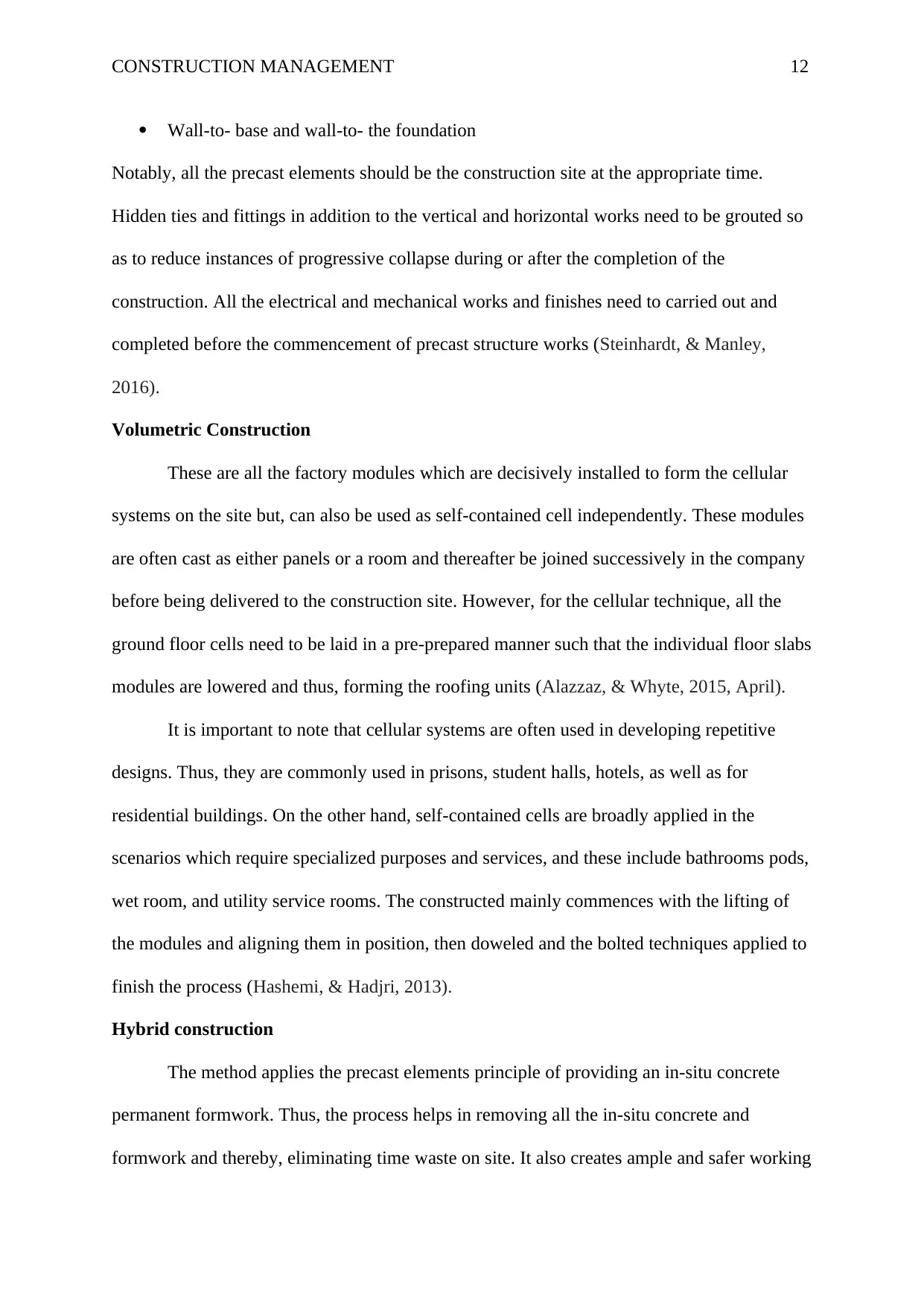
CONSTRUCTION MANAGEMENT 12
Wall-to- base and wall-to- the foundation
Notably, all the precast elements should be the construction site at the appropriate time.
Hidden ties and fittings in addition to the vertical and horizontal works need to be grouted so
as to reduce instances of progressive collapse during or after the completion of the
construction. All the electrical and mechanical works and finishes need to carried out and
completed before the commencement of precast structure works (Steinhardt, & Manley,
2016).
Volumetric Construction
These are all the factory modules which are decisively installed to form the cellular
systems on the site but, can also be used as self-contained cell independently. These modules
are often cast as either panels or a room and thereafter be joined successively in the company
before being delivered to the construction site. However, for the cellular technique, all the
ground floor cells need to be laid in a pre-prepared manner such that the individual floor slabs
modules are lowered and thus, forming the roofing units (Alazzaz, & Whyte, 2015, April).
It is important to note that cellular systems are often used in developing repetitive
designs. Thus, they are commonly used in prisons, student halls, hotels, as well as for
residential buildings. On the other hand, self-contained cells are broadly applied in the
scenarios which require specialized purposes and services, and these include bathrooms pods,
wet room, and utility service rooms. The constructed mainly commences with the lifting of
the modules and aligning them in position, then doweled and the bolted techniques applied to
finish the process (Hashemi, & Hadjri, 2013).
Hybrid construction
The method applies the precast elements principle of providing an in-situ concrete
permanent formwork. Thus, the process helps in removing all the in-situ concrete and
formwork and thereby, eliminating time waste on site. It also creates ample and safer working
Wall-to- base and wall-to- the foundation
Notably, all the precast elements should be the construction site at the appropriate time.
Hidden ties and fittings in addition to the vertical and horizontal works need to be grouted so
as to reduce instances of progressive collapse during or after the completion of the
construction. All the electrical and mechanical works and finishes need to carried out and
completed before the commencement of precast structure works (Steinhardt, & Manley,
2016).
Volumetric Construction
These are all the factory modules which are decisively installed to form the cellular
systems on the site but, can also be used as self-contained cell independently. These modules
are often cast as either panels or a room and thereafter be joined successively in the company
before being delivered to the construction site. However, for the cellular technique, all the
ground floor cells need to be laid in a pre-prepared manner such that the individual floor slabs
modules are lowered and thus, forming the roofing units (Alazzaz, & Whyte, 2015, April).
It is important to note that cellular systems are often used in developing repetitive
designs. Thus, they are commonly used in prisons, student halls, hotels, as well as for
residential buildings. On the other hand, self-contained cells are broadly applied in the
scenarios which require specialized purposes and services, and these include bathrooms pods,
wet room, and utility service rooms. The constructed mainly commences with the lifting of
the modules and aligning them in position, then doweled and the bolted techniques applied to
finish the process (Hashemi, & Hadjri, 2013).
Hybrid construction
The method applies the precast elements principle of providing an in-situ concrete
permanent formwork. Thus, the process helps in removing all the in-situ concrete and
formwork and thereby, eliminating time waste on site. It also creates ample and safer working
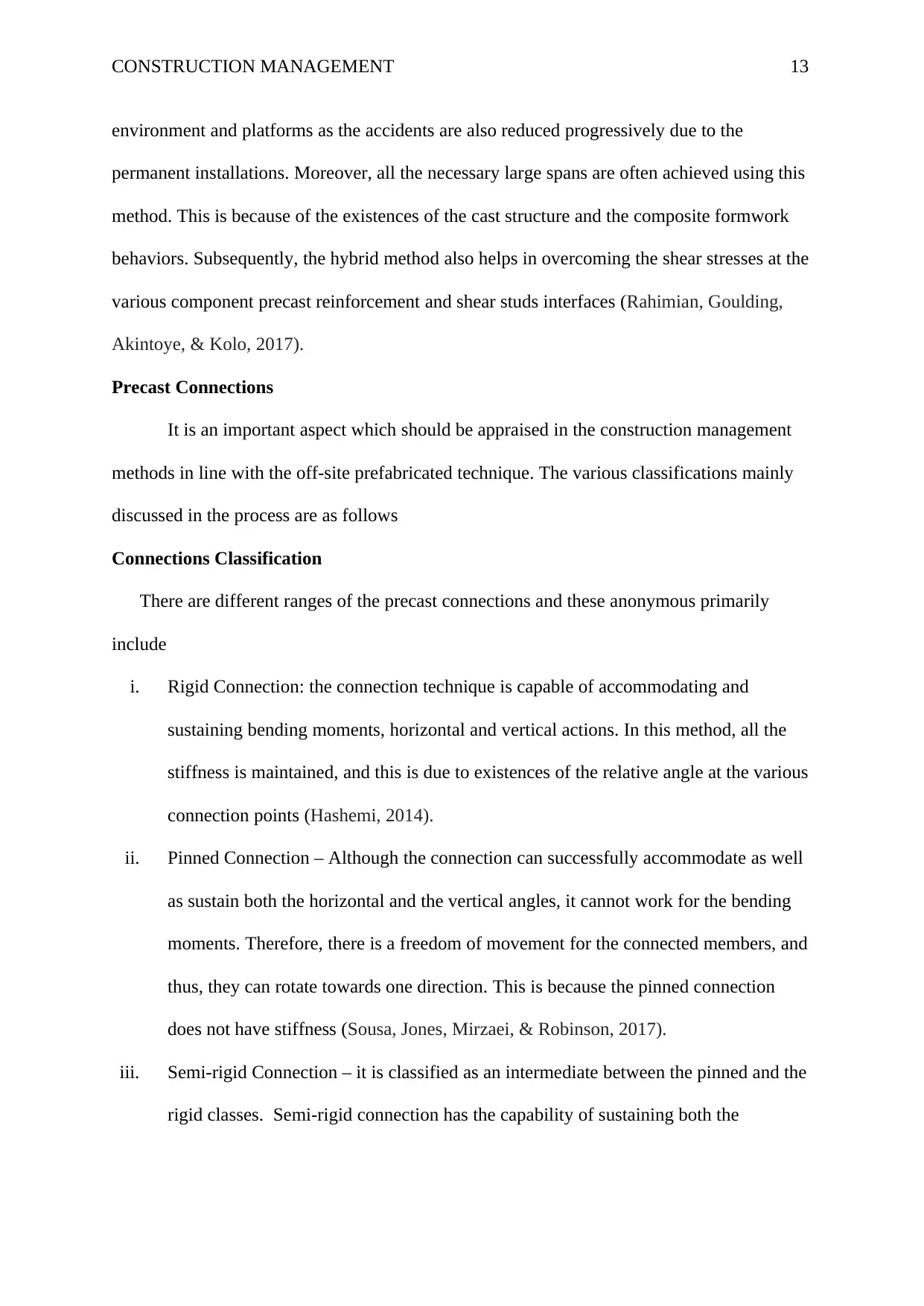
CONSTRUCTION MANAGEMENT 13
environment and platforms as the accidents are also reduced progressively due to the
permanent installations. Moreover, all the necessary large spans are often achieved using this
method. This is because of the existences of the cast structure and the composite formwork
behaviors. Subsequently, the hybrid method also helps in overcoming the shear stresses at the
various component precast reinforcement and shear studs interfaces (Rahimian, Goulding,
Akintoye, & Kolo, 2017).
Precast Connections
It is an important aspect which should be appraised in the construction management
methods in line with the off-site prefabricated technique. The various classifications mainly
discussed in the process are as follows
Connections Classification
There are different ranges of the precast connections and these anonymous primarily
include
i. Rigid Connection: the connection technique is capable of accommodating and
sustaining bending moments, horizontal and vertical actions. In this method, all the
stiffness is maintained, and this is due to existences of the relative angle at the various
connection points (Hashemi, 2014).
ii. Pinned Connection – Although the connection can successfully accommodate as well
as sustain both the horizontal and the vertical angles, it cannot work for the bending
moments. Therefore, there is a freedom of movement for the connected members, and
thus, they can rotate towards one direction. This is because the pinned connection
does not have stiffness (Sousa, Jones, Mirzaei, & Robinson, 2017).
iii. Semi-rigid Connection – it is classified as an intermediate between the pinned and the
rigid classes. Semi-rigid connection has the capability of sustaining both the
environment and platforms as the accidents are also reduced progressively due to the
permanent installations. Moreover, all the necessary large spans are often achieved using this
method. This is because of the existences of the cast structure and the composite formwork
behaviors. Subsequently, the hybrid method also helps in overcoming the shear stresses at the
various component precast reinforcement and shear studs interfaces (Rahimian, Goulding,
Akintoye, & Kolo, 2017).
Precast Connections
It is an important aspect which should be appraised in the construction management
methods in line with the off-site prefabricated technique. The various classifications mainly
discussed in the process are as follows
Connections Classification
There are different ranges of the precast connections and these anonymous primarily
include
i. Rigid Connection: the connection technique is capable of accommodating and
sustaining bending moments, horizontal and vertical actions. In this method, all the
stiffness is maintained, and this is due to existences of the relative angle at the various
connection points (Hashemi, 2014).
ii. Pinned Connection – Although the connection can successfully accommodate as well
as sustain both the horizontal and the vertical angles, it cannot work for the bending
moments. Therefore, there is a freedom of movement for the connected members, and
thus, they can rotate towards one direction. This is because the pinned connection
does not have stiffness (Sousa, Jones, Mirzaei, & Robinson, 2017).
iii. Semi-rigid Connection – it is classified as an intermediate between the pinned and the
rigid classes. Semi-rigid connection has the capability of sustaining both the
Paraphrase This Document
Need a fresh take? Get an instant paraphrase of this document with our AI Paraphraser

CONSTRUCTION MANAGEMENT 14
horizontal and the vertical actions alongside some elements of moments in the
process.
horizontal and the vertical actions alongside some elements of moments in the
process.
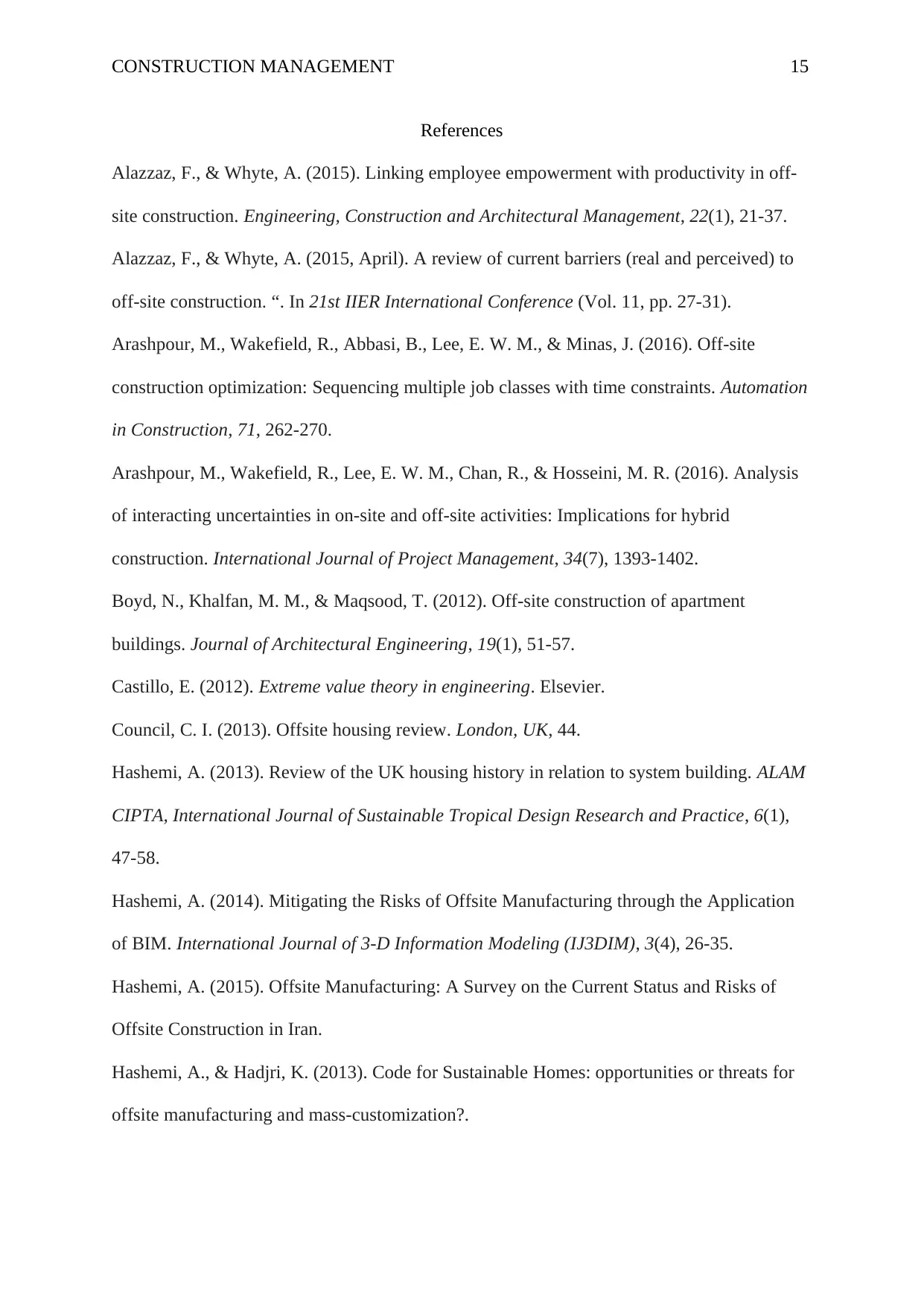
CONSTRUCTION MANAGEMENT 15
References
Alazzaz, F., & Whyte, A. (2015). Linking employee empowerment with productivity in off-
site construction. Engineering, Construction and Architectural Management, 22(1), 21-37.
Alazzaz, F., & Whyte, A. (2015, April). A review of current barriers (real and perceived) to
off-site construction. “. In 21st IIER International Conference (Vol. 11, pp. 27-31).
Arashpour, M., Wakefield, R., Abbasi, B., Lee, E. W. M., & Minas, J. (2016). Off-site
construction optimization: Sequencing multiple job classes with time constraints. Automation
in Construction, 71, 262-270.
Arashpour, M., Wakefield, R., Lee, E. W. M., Chan, R., & Hosseini, M. R. (2016). Analysis
of interacting uncertainties in on-site and off-site activities: Implications for hybrid
construction. International Journal of Project Management, 34(7), 1393-1402.
Boyd, N., Khalfan, M. M., & Maqsood, T. (2012). Off-site construction of apartment
buildings. Journal of Architectural Engineering, 19(1), 51-57.
Castillo, E. (2012). Extreme value theory in engineering. Elsevier.
Council, C. I. (2013). Offsite housing review. London, UK, 44.
Hashemi, A. (2013). Review of the UK housing history in relation to system building. ALAM
CIPTA, International Journal of Sustainable Tropical Design Research and Practice, 6(1),
47-58.
Hashemi, A. (2014). Mitigating the Risks of Offsite Manufacturing through the Application
of BIM. International Journal of 3-D Information Modeling (IJ3DIM), 3(4), 26-35.
Hashemi, A. (2015). Offsite Manufacturing: A Survey on the Current Status and Risks of
Offsite Construction in Iran.
Hashemi, A., & Hadjri, K. (2013). Code for Sustainable Homes: opportunities or threats for
offsite manufacturing and mass-customization?.
References
Alazzaz, F., & Whyte, A. (2015). Linking employee empowerment with productivity in off-
site construction. Engineering, Construction and Architectural Management, 22(1), 21-37.
Alazzaz, F., & Whyte, A. (2015, April). A review of current barriers (real and perceived) to
off-site construction. “. In 21st IIER International Conference (Vol. 11, pp. 27-31).
Arashpour, M., Wakefield, R., Abbasi, B., Lee, E. W. M., & Minas, J. (2016). Off-site
construction optimization: Sequencing multiple job classes with time constraints. Automation
in Construction, 71, 262-270.
Arashpour, M., Wakefield, R., Lee, E. W. M., Chan, R., & Hosseini, M. R. (2016). Analysis
of interacting uncertainties in on-site and off-site activities: Implications for hybrid
construction. International Journal of Project Management, 34(7), 1393-1402.
Boyd, N., Khalfan, M. M., & Maqsood, T. (2012). Off-site construction of apartment
buildings. Journal of Architectural Engineering, 19(1), 51-57.
Castillo, E. (2012). Extreme value theory in engineering. Elsevier.
Council, C. I. (2013). Offsite housing review. London, UK, 44.
Hashemi, A. (2013). Review of the UK housing history in relation to system building. ALAM
CIPTA, International Journal of Sustainable Tropical Design Research and Practice, 6(1),
47-58.
Hashemi, A. (2014). Mitigating the Risks of Offsite Manufacturing through the Application
of BIM. International Journal of 3-D Information Modeling (IJ3DIM), 3(4), 26-35.
Hashemi, A. (2015). Offsite Manufacturing: A Survey on the Current Status and Risks of
Offsite Construction in Iran.
Hashemi, A., & Hadjri, K. (2013). Code for Sustainable Homes: opportunities or threats for
offsite manufacturing and mass-customization?.
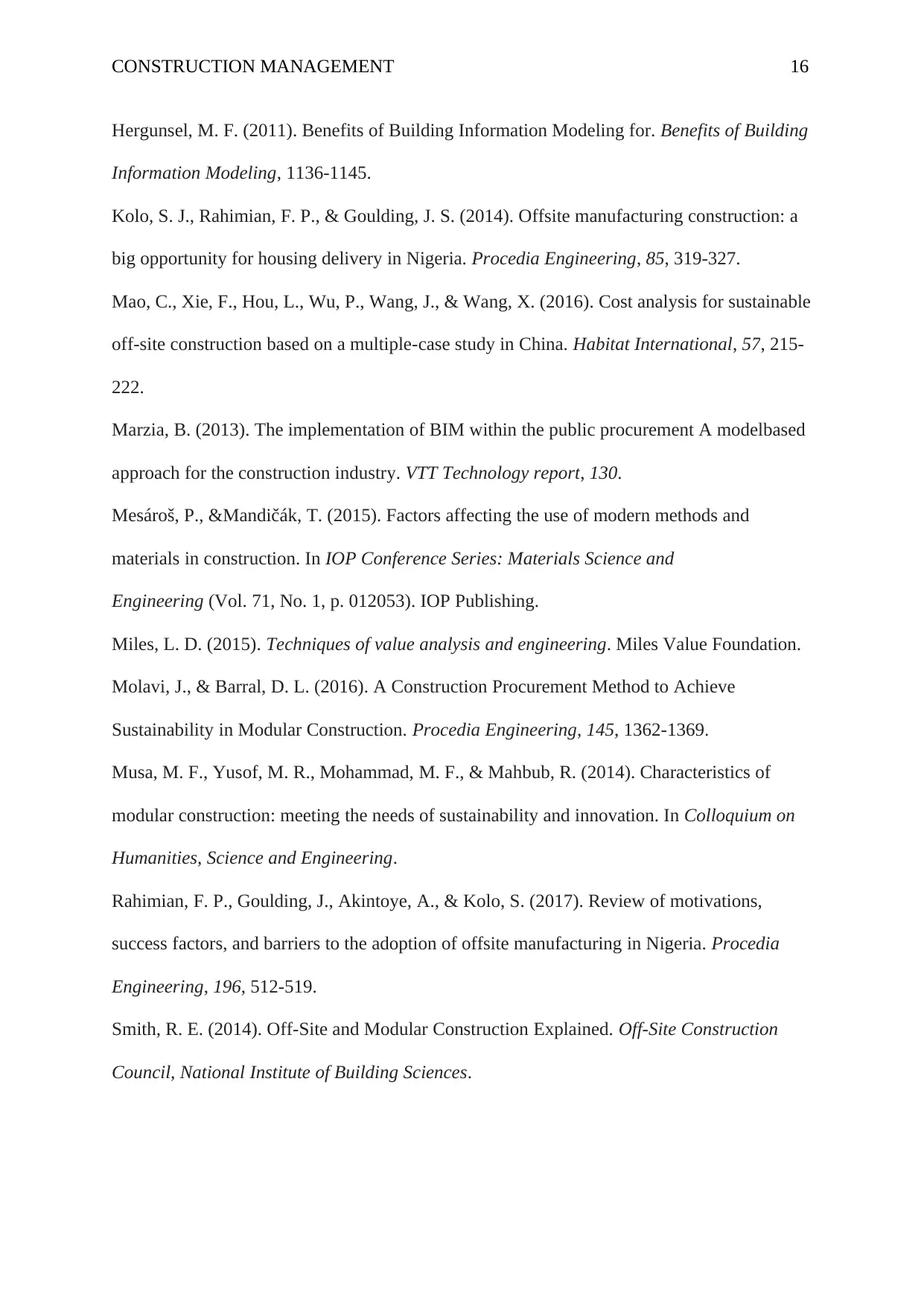
CONSTRUCTION MANAGEMENT 16
Hergunsel, M. F. (2011). Benefits of Building Information Modeling for. Benefits of Building
Information Modeling, 1136-1145.
Kolo, S. J., Rahimian, F. P., & Goulding, J. S. (2014). Offsite manufacturing construction: a
big opportunity for housing delivery in Nigeria. Procedia Engineering, 85, 319-327.
Mao, C., Xie, F., Hou, L., Wu, P., Wang, J., & Wang, X. (2016). Cost analysis for sustainable
off-site construction based on a multiple-case study in China. Habitat International, 57, 215-
222.
Marzia, B. (2013). The implementation of BIM within the public procurement A modelbased
approach for the construction industry. VTT Technology report, 130.
Mesároš, P., &Mandičák, T. (2015). Factors affecting the use of modern methods and
materials in construction. In IOP Conference Series: Materials Science and
Engineering (Vol. 71, No. 1, p. 012053). IOP Publishing.
Miles, L. D. (2015). Techniques of value analysis and engineering. Miles Value Foundation.
Molavi, J., & Barral, D. L. (2016). A Construction Procurement Method to Achieve
Sustainability in Modular Construction. Procedia Engineering, 145, 1362-1369.
Musa, M. F., Yusof, M. R., Mohammad, M. F., & Mahbub, R. (2014). Characteristics of
modular construction: meeting the needs of sustainability and innovation. In Colloquium on
Humanities, Science and Engineering.
Rahimian, F. P., Goulding, J., Akintoye, A., & Kolo, S. (2017). Review of motivations,
success factors, and barriers to the adoption of offsite manufacturing in Nigeria. Procedia
Engineering, 196, 512-519.
Smith, R. E. (2014). Off-Site and Modular Construction Explained. Off-Site Construction
Council, National Institute of Building Sciences.
Hergunsel, M. F. (2011). Benefits of Building Information Modeling for. Benefits of Building
Information Modeling, 1136-1145.
Kolo, S. J., Rahimian, F. P., & Goulding, J. S. (2014). Offsite manufacturing construction: a
big opportunity for housing delivery in Nigeria. Procedia Engineering, 85, 319-327.
Mao, C., Xie, F., Hou, L., Wu, P., Wang, J., & Wang, X. (2016). Cost analysis for sustainable
off-site construction based on a multiple-case study in China. Habitat International, 57, 215-
222.
Marzia, B. (2013). The implementation of BIM within the public procurement A modelbased
approach for the construction industry. VTT Technology report, 130.
Mesároš, P., &Mandičák, T. (2015). Factors affecting the use of modern methods and
materials in construction. In IOP Conference Series: Materials Science and
Engineering (Vol. 71, No. 1, p. 012053). IOP Publishing.
Miles, L. D. (2015). Techniques of value analysis and engineering. Miles Value Foundation.
Molavi, J., & Barral, D. L. (2016). A Construction Procurement Method to Achieve
Sustainability in Modular Construction. Procedia Engineering, 145, 1362-1369.
Musa, M. F., Yusof, M. R., Mohammad, M. F., & Mahbub, R. (2014). Characteristics of
modular construction: meeting the needs of sustainability and innovation. In Colloquium on
Humanities, Science and Engineering.
Rahimian, F. P., Goulding, J., Akintoye, A., & Kolo, S. (2017). Review of motivations,
success factors, and barriers to the adoption of offsite manufacturing in Nigeria. Procedia
Engineering, 196, 512-519.
Smith, R. E. (2014). Off-Site and Modular Construction Explained. Off-Site Construction
Council, National Institute of Building Sciences.
Secure Best Marks with AI Grader
Need help grading? Try our AI Grader for instant feedback on your assignments.
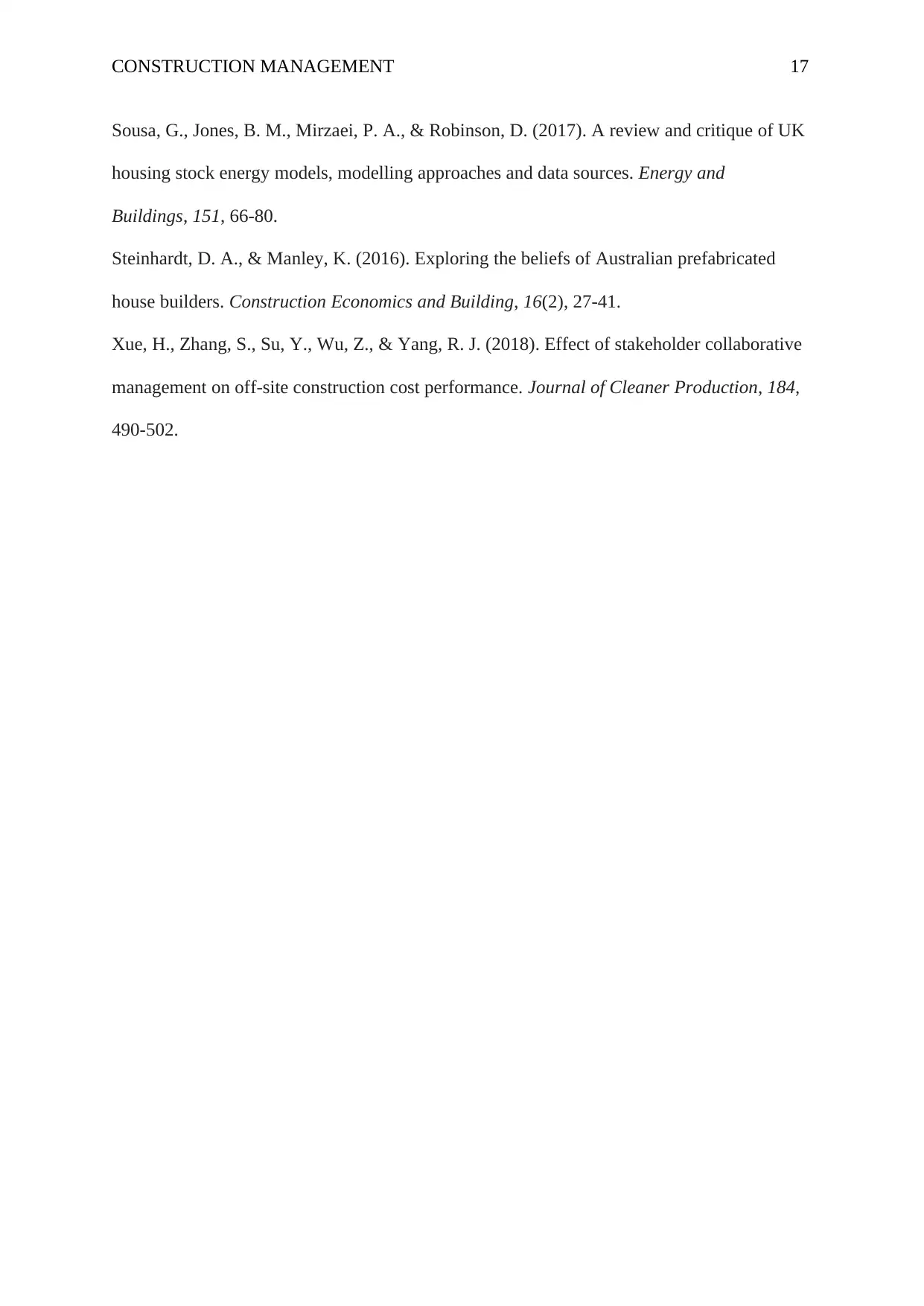
CONSTRUCTION MANAGEMENT 17
Sousa, G., Jones, B. M., Mirzaei, P. A., & Robinson, D. (2017). A review and critique of UK
housing stock energy models, modelling approaches and data sources. Energy and
Buildings, 151, 66-80.
Steinhardt, D. A., & Manley, K. (2016). Exploring the beliefs of Australian prefabricated
house builders. Construction Economics and Building, 16(2), 27-41.
Xue, H., Zhang, S., Su, Y., Wu, Z., & Yang, R. J. (2018). Effect of stakeholder collaborative
management on off-site construction cost performance. Journal of Cleaner Production, 184,
490-502.
Sousa, G., Jones, B. M., Mirzaei, P. A., & Robinson, D. (2017). A review and critique of UK
housing stock energy models, modelling approaches and data sources. Energy and
Buildings, 151, 66-80.
Steinhardt, D. A., & Manley, K. (2016). Exploring the beliefs of Australian prefabricated
house builders. Construction Economics and Building, 16(2), 27-41.
Xue, H., Zhang, S., Su, Y., Wu, Z., & Yang, R. J. (2018). Effect of stakeholder collaborative
management on off-site construction cost performance. Journal of Cleaner Production, 184,
490-502.
1 out of 17
Related Documents
Your All-in-One AI-Powered Toolkit for Academic Success.
+13062052269
info@desklib.com
Available 24*7 on WhatsApp / Email
![[object Object]](/_next/static/media/star-bottom.7253800d.svg)
Unlock your academic potential
© 2024 | Zucol Services PVT LTD | All rights reserved.





